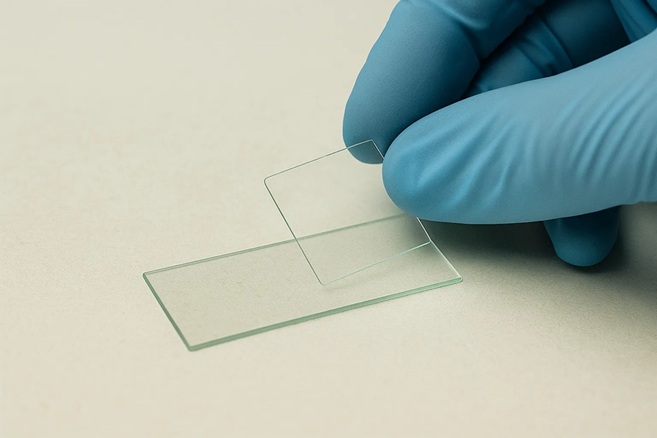
In the world of microscopy, where every micron matters, the clarity and accuracy of observation depend on more than just the microscope itself. While lenses often steal the spotlight, one of the most crucial components in ensuring sharp images and clean results is the microscope cover glass.
These thin sheets of optical glass may appear unremarkable, but their role is anything but. From academic laboratories and medical diagnostics to forensic science and material analysis, microscopic cover glass plays a crucial yet often overlooked role in successful sample observation.
Let’s explore what makes the microscope slide cover a non-negotiable tool for scientists, researchers, and educators worldwide.
What is a Microscope Cover Glass?
A microscope cover glass — also referred to as a cover slip, is a thin, flat piece of transparent glass placed over a specimen mounted on a microscope slide. Its primary purpose is to flatten the sample, protect the microscope’s objective lens, and create a uniform thickness for light to pass through — ensuring clear, distortion-free viewing.
Typically made from high-quality borosilicate or soda-lime glass, these covers are produced with precision to offer specific thicknesses, ranging from 0.13 mm to 0.22 mm (Class 1 or No. 1.5 being the most commonly used).
Why the Cover Glass Matters in Microscopy
At first glance, using a microscopic cover glass may seem like a simple finishing touch. But in practice, it directly impacts:
- Image Clarity
A uniform cover glass ensures even refraction and minimizes spherical aberrations. Without it, light may scatter, leading to blurry images or optical distortion.
- Sample Preservation
The microscope cover acts as a protective barrier, reducing sample dehydration and contamination, especially important for biological specimens.
- Lens Protection
Oil-immersion objectives or high-powered dry lenses are expensive and delicate. The cover slip prevents accidental contact between the sample and the lens, reducing wear and tear.
- Standardisation of Observations
Certain high-resolution microscopes are calibrated assuming a specific cover glass thickness. Using an inaccurate type can skew results or make focusing difficult.
Applications Across Scientific Fields
The use of a microscope slide cover extends across a wide range of disciplines, with each application demanding specific standards of quality:
- Medical Pathology
Tissue samples, smears, and body fluids are examined under a microscope to aid in diagnostics, from identifying cancerous cells to detecting infections.
- Microbiology
In studying bacteria, viruses, and protozoa, the cover glass helps create wet mounts, allowing organisms to be seen in motion.
- Botany and Zoology
Plant cells, algae, and microscopic invertebrates are often mounted beneath a microscope cover glass to study morphology, structure, and reproduction.
- Forensics
Trace evidence such as fibres, residues, or hair strands are often secured and analysed under a cover to preserve integrity.
- Material Science
Thin-sectioned minerals, metals, and synthetic materials are observed under covers to inspect defects, textures, and compositions.
Key Features to Look for in Cover Glasses
Not all cover glasses are created equal. Quality, consistency, and compatibility are essential in ensuring accuracy and usability. When selecting a microscope cover, professionals typically look for:
- Optical Clarity: The glass should be free from bubbles, scratches, or colour tinting that could affect observation.
- Thickness Accuracy: Whether it’s Class 0, 1, or 1.5, the product should strictly conform to international thickness standards.
- Cleanliness: High-quality microscope slide covers are pre-cleaned, lint-free, and free from oily residues.
- Dimension Consistency: Each cover glass should be uniformly sized, whether it’s square (18×18 mm) or rectangular (24×50 mm).
- Durability: While thin, the covers must resist chipping or cracking during handling and placement.
Common Mistakes to Avoid When Using a Cover Glass
Even seasoned lab technicians can make errors that affect the outcome of their microscopy work. Here are a few common issues to avoid:
- Using the wrong thickness for high-resolution microscopes
- Applying the cover unevenly, leading to air bubbles
- Touching the surface with bare fingers, which leaves oil and smudges
- Reusing covers can compromise sterility and optical quality
Proper training and careful handling of the microscopic cover glass go a long way in maintaining consistency and quality in lab work.
Innovations in Microscope Cover Glass Technology
As microscopes evolve, so do the demands placed on peripheral tools, such as cover slips. Advanced research and medical diagnostics need higher clarity, compatibility with digital imaging, and chemical resistance.
Recent innovations include:
- Hydrophobic coatings to prevent fluid spreading.
- Anti-reflective coatings for clearer fluorescence imaging.
- Pre-marked covers for sample orientation.
- Siliconized surfaces to prevent sample adhesion.
Such features help modern microscope cover glass products remain relevant in lab environments.
Packaging and Sterilisation Considerations
High-quality microscope slide covers often come in moisture-proof, anti-static packaging to maintain cleanliness. Some laboratories may prefer pre-sterilised options, especially in microbiological or clinical environments.
Sterile packaging also reduces time spent on pre-cleaning and minimises contamination risks, particularly in high-volume research settings.
Sustainable Options and Disposal
While microscope covers are reusable in some non-clinical settings, many labs now use disposable covers to maintain hygiene. Glass, being a recyclable material, necessitates proper disposal and recycling. Increasingly, environmentally conscious labs are partnering with recycling facilities or adopting green lab protocols to ensure sustainable use of microscope cover products.
While often overlooked, the microscope cover glass is a fundamental component of every successful microscopy setup. These covers are typically used along with a high-quality microscope slide to ensure accurate and reliable results. From protecting fragile specimens to enabling precise, distortion-free imaging, these delicate sheets of glass ensure that science is seen as it truly is. Whether you’re working in diagnostics, research, or teaching, investing in the right microscopic cover glass or microscope slide cover makes all the difference. With evolving standards and emerging technologies, the humble microscope cover continues to play a powerful role in the clarity, safety, and effectiveness of lab-based discoveries.
